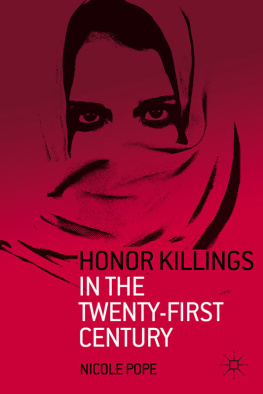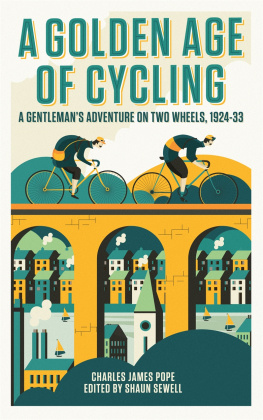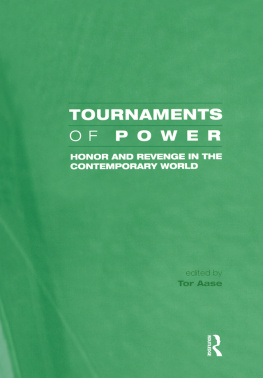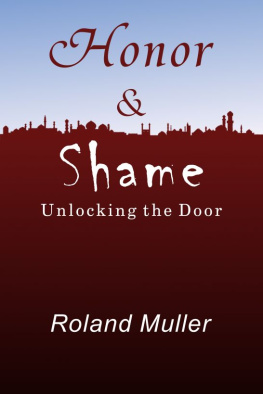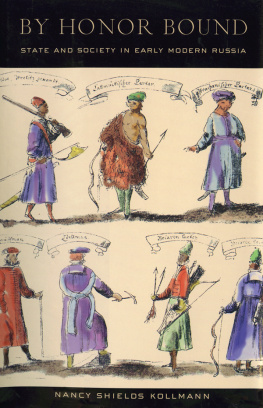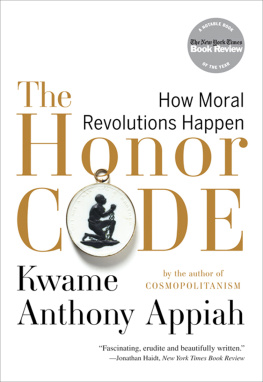HONOR KILLINGS IN THE TWENTY-FIRST CENTURY
HONOR KILLINGS IN THE TWENTY-FIRST CENTURY
Nicole Pope


HONOR KILLINGS IN THE TWENTY-FIRST CENTURY
Copyright Nicole Pope, 2012.
All rights reserved.
First published in 2012 by
PALGRAVE MACMILLAN
in the United Statesa division of St. Martins Press LLC, 175 Fifth Avenue, New York, NY 10010.
Where this book is distributed in the UK, Europe and the rest of the World, this is by Palgrave Macmillan, a division of Macmillan Publishers Limited, registered in England, company number 785998, of Houndmills, Basingstoke, Hampshire RG21 6XS.
Palgrave Macmillan is the global academic imprint of the above companies and has companies and representatives throughout the world.
Palgrave and Macmillan are registered trademarks in the United States, the United Kingdom, Europe and other countries.
ISBN: 9780230339781
Library of Congress Cataloging-in-Publication Data
Pope, Nicole.
Honor killings in the twenty-first century / Nicole Pope.
p. cm.
Includes bibliographical references.
ISBN 9780230339781 (alk. paper)
1. WomenViolence against. 2. Honor killings.
3. Honor killingsCase studies. 4. Womens rights.
5. HonorSocial aspects. I. Title.
HV6250.4.W65P635 2011
306.87dc23 2011024737
A catalogue record of the book is available from the British Library.
Design by Integra Software Services
First edition: January 2012
10 9 8 7 6 5 4 3 2 1
Printed in the United States of America.
To my daughters Vanessa and Amanda
And to my parents Pierre and Lisi Bernet
CONTENTS
PREFACE
I beg the ancient privilege of Athens,
As she is mine, I may dispose of her:
Which shall be either to this gentleman
Or to her death, according to our law
Immediately provided in that case.
Egeus, father of Hermia
Act I, Scene I
A Midsummer Nights Dream,
by William Shakespeare
When I set out to write about honor killings, I had no idea that I would embark on an emotional journey that would last a decade and would prove challenging, professionally and personally.
I had a fairly simplesimplistic, it turned outidea in mind. I had spent more than 20 years in the Middle East and in Turkey. In the course of my work as a journalist, I had stumbled upon cases of murders committed in the name of honor. Like most people who hear about these crimes, I was appalled and moved by the deaths of innocent young women. But I was also intrigued and wanted to find out more about the circumstances that led to their deaths. The individual stories described in news reports suggested that entire communities were involved.
I struggled with the idea that an attachment to an unwritten social code could be powerful enough to override human instinct and push parents to kill the children they had brought into the world. I wanted to examine the social mechanisms that could drive them to such extremes and find out what went on in the minds of perpetrators.
I started by looking at specific cases of what I thought of as textbook honor killings. The pattern, it then seemed to me, was quite clear: a young woman is perceived to have tarnished the family honor, her relatives gather to decide her fate, and one family member is given the mandate to kill her.
But I soon realized that a blanket of honor was thrown over a much broader variety of crimes and abuses, and that cases of honor killings that seemed to follow a kind of tribal pattern were in fact only the tip of the iceberg.
Violence committed in the name of honor has to be examined in the wider context of a patriarchal structure that assigns specific roles to its members according to their gender. Crimes committed in the name of honor, often wrongly described in Western media as an Islamic practice, can only be properly addressed when studied in conjunction with practices such as forced marriages and bride exchanges, as well as with the cult of virginity and the expectation of total obedience on the part of women, which provide the social backdrop to these crimes wherever they occur.
Many of the cases outlined in this book do not involve informal family courts handing down death sentences. They may not neatly fit the stereotype of honor killings as described in Western media. Some of them do not even result in a murder. But all the tragedies outlined in this book are linked by a common thread, and each shines a light on a different aspect of what is sometimes described as the honor culture.
Inverted commas are needed to frame the word honor because discrimination and violence against women are never honorable, even if the perpetrators believe they are redeeming their or their familys reputation. For practical reasons, I did not use them throughout the text but they are always implied when honor is attached to the notion that women should be obedient and conform to a behavior determined by male members of the community.
Culture, in this context, does not refer to the set of customs of one specific country or religion. Patriarchal values, and the practices that evolve from them, take on different forms from one country to the next. They can even vary between neighboring villages. Although many of these practices have roots that reach back in time, they are neither monolithic nor immutable. In fact, they are constantly evolving.
Different lifestyles also coexist within a country. In places where honor-based violence is still reported, I also met educated or well-off women, who enjoyed rights and freedoms similar to their counterparts in the West. The harmful practices outlined in this book were largely alien to them. And even among men and women from less privileged backgrounds, I met many who rejected the harmful aspects of their traditions and bravely fought from within their communities to effect change.
While my research led me to closely examine gender relations in countries where crimes are still committed in the name of honor, it also forced me to take a closer look at the situation of women in developed Western countries. I had not really anticipated that this project would take me down this path. Observed from the safe distance of newspaper clippings, honor-based violence seemed to stem from traditions so different from the ones I had grown up with that they appeared to have no bearing on gender issues in Western societies.
A closer examination of the global situation of women, however, reveals a continuum of violence against them. Honor killings are undoubtedly at the extreme end of the spectrum, but they cannot be entirely detached from forms of violence that Westerners are more familiar with and therefore often less sensitive to. I personally believe that an arch of patriarchal bullying links honor killings to crimes committed against women in Western societies, even if the narrative and the sociopolitical background are different.
I went looking for traditions and found instead a scourge that, in many cases, takes on very modern forms. Honor killings may have existed for centuries or even millennia, but they have also evolved to maintain their grip in a rapidly changing world.
I therefore felt that it was important to look at them from a broader perspective and examine how they take place in different environments. I collected essays and media reports from various countries, but narrowed the area of field research to Turkey, where I live and have easy access to information, partly through womens rights groups; to Pakistan, a country where honor killings remain frequent but are also well documented thanks to the tireless efforts of human rights activists; and to the United Kingdom, a country that has discovered honor killings and related issues such as forced marriages in recent years.
Next page
